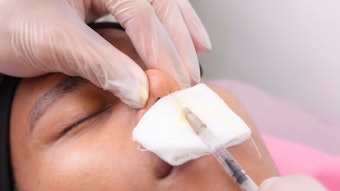
McKinsey & Company's "Life Sciences Practice" report suggests an optimistic future for the medical aesthetics industry. The report projects the industry to grow by as much as 14% annually through 2026, due to an expanding patient base, a proliferation of outlets providing aesthetic services, the expansion of indications, the adoption of new technologies and new service delivery channels rising to meet consumer needs.
The report also draws from a 2022 survey in the United States by McKinsey & Company to assess consumer sentiment and attitudes toward spending on medical aesthetics, particularly in light of the evolving macroeconomic environment.
Related: Snail Serums and AviClear Acne Laser are Currently Top Skin Care Trends: Spate
Market Report
The report indicates that medical aesthetics in Canada and the United States, which represents an outsize share of the global market, has enjoyed a steady climb since 2019, as illustrated by neuromodulator and dermal filler injectables and energy-based devices for facial rejuvenation and hair removal. The market recovered quickly from the COVID-19 pandemic and shifted towards an increased interest in neuromodulators over dermal fillers.
Private equity acquisitions grew approximately 30% per annum from 2019 to 2021. Deals with a strategic buyer nearly doubled from 2019 to 2021, with providers adding to their platforms and manufacturers expanding or diversifying product portfolios, per the report.
The report indicates that now could be an opportune time to capitalize on current and projected consumer demand for medical aesthetics and invest in innovations. Previous analysis from McKinsey showed that healthcare manufacturers and providers that innovate during a crisis and maintain their focus on growth and rapid adaptability tend to outperform the competition.
6 Signs of Future Market Prosperity
As consumer bases expand, providers could optimize the mix of products and treatments to include surgical aesthetics and at-home offerings. New business models, like subscriptions for neuromodulators and devices for facial rejuvenation, are other growth opportunities outlined in the report.
McKinsey & Company listed six factors that point toward a bright future for medical aesthetics.
1. Many consumers are still spending, but lean toward cost-effective options
Roughly 60% of respondents to the McKinsey Aesthetics Consumer Survey expected to spend at least 10% less on medical aesthetics should a recession occur. This sentiment is reportedly driven by price sensitivity: approximately 46% expressed a willingness to switch to lower-price brands or products. Only 7% of respondents across the neuromodulator, dermal filler and facial-rejuvenation segments expected to stop their treatments entirely.
2. Even amid financial constraints, many consumers remain brand-loyal
Despite a general inclination to reduce spending, some respondents intended to stick with their current brands and treatments, including 52% of consumers who were receiving neuromodulator injections. Fewer than 20% of respondents across all three categories intended to abandon their current products or treatment plans entirely, per the report.
3. An increasingly diverse consumer base is now more open to medical aesthetics
The report suggests there is a widespread and dramatic shift regarding aesthetics acceptance and self-image. Consumer segments have also expanded and become more diverse. Social media is playing an increasingly critical role in consumer perception. The American Academy of Facial Plastic and Reconstructive Surgery has noted that social media users are moving from wanting aesthetic treatments to achieve the static “Instagram face” to seeking the more dynamic “TikTok face.” They also reported that 79% of facial plastic surgeons agree that consumer demand is increasing for procedures that help them look better in selfies, maintain previous procedures and reduce signs of aging.
4. Manufacturers are innovating to meet growing consumer demand
Technological innovation has risen to meet the needs of an increasingly demanding, diverse and discerning consumer base. The report indicates that recent innovations are addressing some consumers’ most challenging pain points, including the maintenance of neuromodulator injections, the treatment of skin laxity and severe acne. Examples of recently approved medical aesthetic innovations identified in the report are Revance’s Daxxify and Galderma’s Alluzience, two new neuromodulator formulations; Cytrellis’s ellacor, a nonsurgical skin removal treatment for skin laxity in the mid-to-lower face, and Cutera’s AviClear, a laser treatment of mild-to-severe acne.
5. Channel proliferation offers more options to reach a wider array of consumers
Growth in consumer diversity and technological innovations is increasing heterogeneity across channels and provider types. Patients of dermatologists were most likely to stick with their provider, who could leverage these trust-based relationships to broaden customers’ access to a range of aesthetic treatments. Medical spas and aesthetic clinics offer appealing options for shoppers seeking promotions and discounts, but the report indicates their customers were less loyal than those treated by individual practitioners. Although some services, like injectables, will continue to be delivered in person, many other treatments, including at-home skin care and hair removal, are available through a hybrid model that includes online channels.
6. The market remains underpenetrated
McKinsey's report indicates that all medical-aesthetics product segments have consumers who say they will try a product or treatment within the next five years or specifically the next 12 months. Fence sitters are an important indicator of future growth potential in an industry, according to the report. Fence sitter consumers in medical aesthetics remained unaffected by significant changes in the macroeconomic environment as reported by McKinsey.
In 2021, McKinsey found that 15 to 20% of respondents intended to use injectables within the next five years, which would double the number of survey respondents who currently used those products at the time of the survey. The 2022 findings provided similar results, and those who hadn’t used dermal fillers intended to do so in the next 12 months. In the survey, 11% of respondents said they intended to use dermal fillers, which would triple the number of current users at the time of the survey











